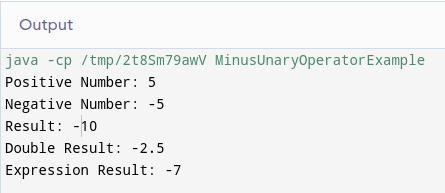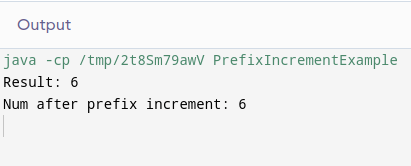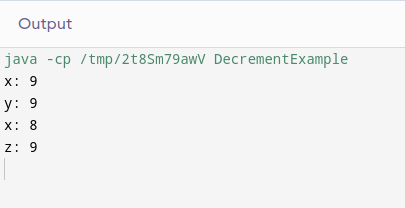Introduction
In the World of Programming, Java Is a Powerhouse. It Is a Versatile Language That Provides Developers With a Wide Range of Tools and Features. An Essential Aspect of Java That Every Programmer Should Understand Is Unary Operators. These Operators Play a Vital Role in Manipulating Variables and Are Fundamental in Java Programming. In This Article, We Will Take a Deeper Dive Into Unary Operators in Java, Exploring What They Are, How They Work, and Practical Examples of Their Usage.
Unary Operator in Java – Video For You
Understanding Unary Operators
Unary Operators Are Operators That Work With a Single Operand, Meaning They Operate on Only One Variable or Value. Java Provides a Set of Unary Operators That Can Be Used to Perform Various Operations on Variables. Let’s Take a Closer Look at the Most Common Unary Operators in Java:
1. Plus Unary Operator (+)
The Plus Unary Operator Is Used to Indicate a Positive Value of a Numerical Expression. For Example, if You Have a Variable X With a Value of -5, Applying the Plus Unary Operator (+X) To It Will Result in 5.
Example:
public class UnaryPlusExample {
public static void main(String[] args) {
int number = 5;
// Using the unary plus operator to show the positive value of 'number'
int positiveNumber = +number;
System.out.println("Original Number: " + number);
System.out.println("Positive Number: " + positiveNumber);
}
}
2. Minus Unary Operator (-)
On the Other Hand, the minus Unary Operator Is Used to Negate the Value of a Numerical Expression. If We Have a Variable Y With a Value of 8, Then Applying the minus Unary Operator to It (-Y) Will Result in -8.
Example:
public class MinusUnaryOperatorExample {
public static void main(String[] args) {
int positiveNumber = 5;
int negativeNumber = -positiveNumber; // Using the minus unary operator to negate the positiveNumber
System.out.println("Positive Number: " + positiveNumber);
System.out.println("Negative Number: " + negativeNumber);
// You can also use the minus unary operator directly on literals or expressions
int result = -10; // Using the minus unary operator on a literal
double doubleResult = -2.5; // Using the minus unary operator on a double literal
int expressionResult = -(3 + 4); // Using the minus unary operator on an expression
System.out.println("Result: " + result);
System.out.println("Double Result: " + doubleResult);
System.out.println("Expression Result: " + expressionResult);
}
}
3. Increment Unary Operator (++)
The Increment Unary Operator Is Used to Increase the Value of a Variable by 1. It Can Be Implemented as a Postfix Operator (X++) Or a Prefix Operator (++X), Each With Slightly Different Behavior.
Example:
After Increment (Variable++):
public class PostfixIncrementExample {
public static void main(String[] args) {
int num = 5;
int result = num++; // num is used first (5), then incremented to 6
System.out.println("Result: " + result); // Output: 5
System.out.println("Num after postfix increment: " + num); // Output: 6
}
}
Prefix Increment(++Variable):
public class PrefixIncrementExample {
public static void main(String[] args) {
int num = 5;
int result = ++num; // num is incremented to 6, then used
System.out.println("Result: " + result); // Output: 6
System.out.println("Num after prefix increment: " + num); // Output: 6
}
}
4. Decrement Unary Operator (–)
The Decrement Unary Operator, Similar to the Increment Operator, Decreases the Value of a Variable by 1. It Can Also Be Used as a Postfix (X–) Or Prefix (–X) Operator.
Pre-reduction (–Var):
In This Form, the Value of the Variable Is decreased before Using It in the Expression.
After Increment (Var–):
In This Form, the Value of the Variable Is Used in the Expression Before the Decrement.
Example:
public class DecrementExample {
public static void main(String[] args) {
int x = 10;
// Pre-decrement
int y = --x; // x is decremented to 9, then assigned to y
System.out.println("x: " + x); // Output: x: 9
System.out.println("y: " + y); // Output: y: 9
// Post-decrement
int z = x--; // x (with value 9) is assigned to z, then decremented
System.out.println("x: " + x); // Output: x: 8
System.out.println("z: " + z); // Output: z: 9
}
}
Practical Uses of Unary Operators
Now That We’ve Covered the Basics, Let’s Learn How Unary Operators Can Be Used in Real-World Scenarios:
1. Arithmetic Calculation
Unary Operators Are Frequently Used in Arithmetic Calculations. For Example, When You Need to Change the Sign of a Number or Adjust the Value of a Variable Based on Certain Conditions.
2. Loop Control
In Java, You Often Use Unary Operators in Loop Control Statements Like ‘For’ and ‘While’. They Can Be Used to Increment or Decrement Loop Counters, Allowing You to Control the Flow of Your Program.
3. Type Casting
Unary Operators Can Also Be Used for Type Casting. You Can Convert One Data Type to Another Using These Operators When Needed.
4. Logical Negation
Unary Operators Can Negate the Value of a Boolean Expression, Making It Essentially Its Opposite.
Conclusion
Unary Operators in Java Are Powerful Tools That Allow Developers to Manipulate Variables and Efficiently Control Program Flow. Whether You Need to Perform Arithmetic Operations, Control Loops, or Cast Data Types, Unary Operators Play a Vital Role in Java Programming. Understanding How to Use Them Effectively Can Greatly Improve Your Coding Skills.
Access Now: How to Use the Java Scanner Class
FAQ
1. Are Unary Operators Only for Java?
No, Unary Operators Are Not Exclusive to Java. They Exist in Different Programming Languages, but Their Usage and Behavior May Differ.
2. Can I Use Multiple Unary Operators in the Same Expression?
Yes, You Can Use Multiple Unary Operators in the Same Expression, but Be Careful as It May Make Your Code Less Readable.
3. What Is the Difference Between Prefix and Postfix Increment/Decrement Operators?
Prefix Increment/Decrement Operators (++X and –X) Change the Value of a Variable Before Using It in an Expression, While Postfix Operators (X++ and X–) Use the Current Value and Then Change It.
4. Are There Any Unary Operators for Non-numeric Data Types?
Unary Operators Are Mainly Used for Numeric Data Types. Other Data Types Have Their Own Set of Operators for Manipulation.
5. Where Can I Learn More About Java Operators and Their Uses?
You Can Find Extensive Resources and Tutorials on Java Operators in Various Programming Books and Online Courses Dedicated to Java Programming.
